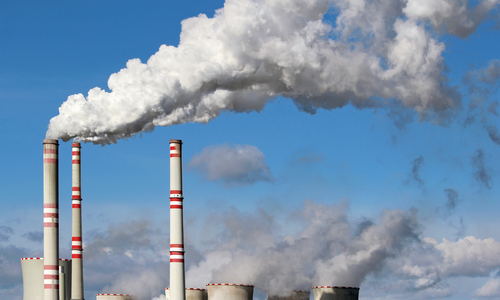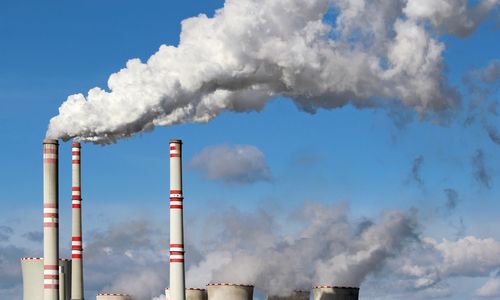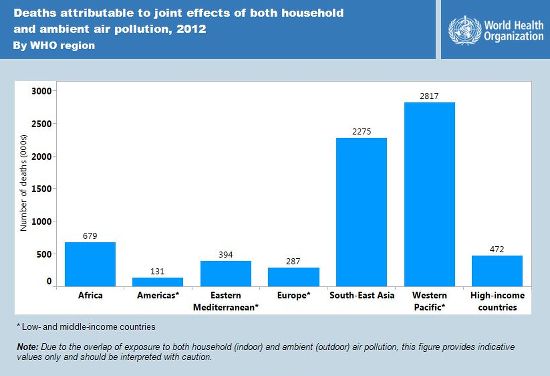
World Health Organization Reports Air Pollution Killed 7 Million People in 2012

In new estimates released Tuesday, the World Health Organization (WHO) reported about 7 million people died as a result of air pollution exposure in 2012.
Photo courtesy of Shutterstock
This finding more than doubles previous estimates and confirms that air pollution is now the world’s largest single environmental health risk as 1 in every 8 deaths is linked to it.
In particular, the new research reveals a stronger connection between both indoor and outdoor air pollution exposure and cardiovascular diseases, such as strokes and heart disease, as well as cancer. The report also found air pollution plays a role in the development of respiratory diseases, including acute respiratory infections and chronic obstructive pulmonary diseases.
The new estimates used improved measurements and technology, enabling scientists to make a more detailed analysis of health risks from a wider demographic spread that now includes both urban and rural areas.
Low- and middle-income countries in the WHO South-East Asia and Western Pacific Regions had the largest air pollution-related burden in 2012, with a total of 3.3 million deaths linked to indoor air pollution and 2.6 million deaths related to outdoor air pollution.
“Cleaning up the air we breathe prevents noncommunicable diseases as well as reduces disease risks among women and vulnerable groups, including children and the elderly,” said Dr Flavia Bustreo, WHO assistant director of General Family, Women and Children’s Health. “Poor women and children pay a heavy price from indoor air pollution since they spend more time at home breathing in smoke and soot from leaky coal and wood cook stoves.”
Included in the assessment is a breakdown of deaths attributed to specific diseases, which shows the vast majority of air pollution deaths are tied to cardiovascular diseases.
Outdoor Air Pollution-Caused Deaths—Breakdown by Disease:
- 40 percent: Ischaemic heart disease
- 40 percent: Stroke
- 11 percent: Chronic obstructive pulmonary disease
- 6 percent: Lung cancer
- 3 percent: Acute lower respiratory infections in children
Indoor Air Pollution-caused deaths—Breakdown by Disease:
- 34 percent: Stroke
- 26 percent: Ischaemic heart disease
- 22 percent: Chronic obstructive pulmonary disease
- 12 percent: Acute lower respiratory infections in children
- 6 percent: Lung cancer
The estimates of people’s exposure to outdoor air pollution in different parts of the world were tabulated using a new global data mapping system, which incorporated satellite data, ground-level monitoring measurements and data on pollution emissions from key sources, as well as modeling of how pollution drifts in the air.
Risk Factors Are Greater Than Expected
“The risks from air pollution are now far greater than previously thought or understood, particularly for heart disease and strokes,” said Dr Maria Neira, director of WHO’s Department for Public Health, Environmental and Social Determinants of Health. “Few risks have a greater impact on global health today than air pollution; the evidence signals the need for concerted action to clean up the air we all breathe.”
WHO estimates indoor air pollution was linked to 4.3 million deaths in 2012 in households cooking over coal, wood and biomass stoves.
Regarding outdoor air pollution, WHO estimates there were 3.7 million deaths in 2012 from urban and rural sources worldwide.
“Excessive air pollution is often a by-product of unsustainable policies in sectors such as transport, energy, waste management and industry,” said Dr Carlos Dora, WHO coordinator for Public Health, Environmental and Social Determinants of Health. “In most cases, healthier strategies will also be more economical in the long term due to healthcare cost savings as well as climate gains. WHO and health sectors have a unique role in translating scientific evidence on air pollution into policies that can deliver impact and improvements that will save lives.”
Later this year, WHO will release indoor air quality guidelines on household fuel combustion, as well as country data on outdoor and indoor air pollution exposures and related mortality, plus an update of air quality measurements in 1,600 cities from all regions of the world.
——–
Related Content:
9 Chinese Cities Exceeded Beijing’s Abysmal 2013 Air Pollution Levels
Science on Trial: Big Oil Funds Attacks on EPA Air Pollution Standards
East Coast Sick of Midwest’s Cross-State Air Pollution

 233k
233k  41k
41k  Subscribe
Subscribe 

